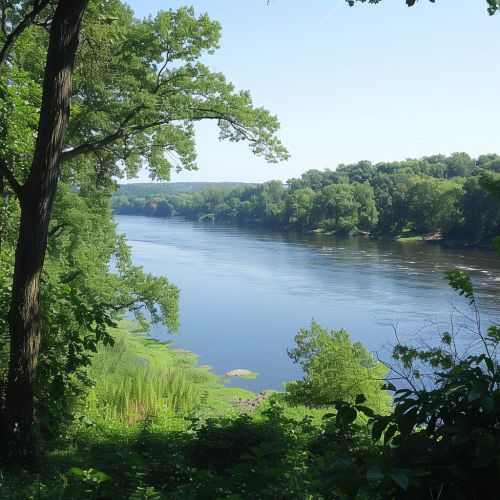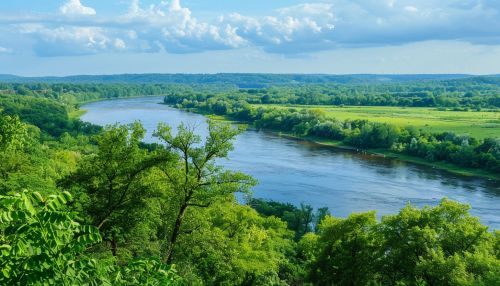Schuylkill River: Difference between revisions
(Created page with "==Geography== The Schuylkill River is a major waterway in the state of Pennsylvania, United States. It spans approximately 135 miles (217 km) from its source in the Appalachian Mountains to its confluence with the Delaware River in Philadelphia. The river's name, derived from the Dutch word for "hidden river", reflects its discovery by early European settlers. <div class='only_on_desktop image-preview'><div class='image-preview-loader'></div></div><div class...") |
No edit summary |
||
| Line 2: | Line 2: | ||
The [[Schuylkill River]] is a major waterway in the state of [[Pennsylvania]], United States. It spans approximately 135 miles (217 km) from its source in the Appalachian Mountains to its confluence with the [[Delaware River]] in Philadelphia. The river's name, derived from the Dutch word for "hidden river", reflects its discovery by early European settlers. | The [[Schuylkill River]] is a major waterway in the state of [[Pennsylvania]], United States. It spans approximately 135 miles (217 km) from its source in the Appalachian Mountains to its confluence with the [[Delaware River]] in Philadelphia. The river's name, derived from the Dutch word for "hidden river", reflects its discovery by early European settlers. | ||
[[Image:Detail-78993.jpg|thumb|center|A view of the Schuylkill River, showcasing its wide expanse and the lush greenery along its banks.|class=only_on_mobile]] | |||
[[Image:Detail-78994.jpg|thumb|center|A view of the Schuylkill River, showcasing its wide expanse and the lush greenery along its banks.|class=only_on_desktop]] | |||
The river's course traverses a diverse range of landscapes, from the rugged terrain of the [[Appalachian Mountains]] to the urbanized areas of [[Philadelphia]]. It flows through several counties, including Schuylkill, Berks, Montgomery, and Philadelphia, serving as a vital resource for these regions. | The river's course traverses a diverse range of landscapes, from the rugged terrain of the [[Appalachian Mountains]] to the urbanized areas of [[Philadelphia]]. It flows through several counties, including Schuylkill, Berks, Montgomery, and Philadelphia, serving as a vital resource for these regions. | ||
Latest revision as of 12:19, 16 May 2024
Geography
The Schuylkill River is a major waterway in the state of Pennsylvania, United States. It spans approximately 135 miles (217 km) from its source in the Appalachian Mountains to its confluence with the Delaware River in Philadelphia. The river's name, derived from the Dutch word for "hidden river", reflects its discovery by early European settlers.


The river's course traverses a diverse range of landscapes, from the rugged terrain of the Appalachian Mountains to the urbanized areas of Philadelphia. It flows through several counties, including Schuylkill, Berks, Montgomery, and Philadelphia, serving as a vital resource for these regions.
History
The Schuylkill River has played a significant role in the history of Pennsylvania. Native American tribes, such as the Lenape, utilized the river for transportation and sustenance long before European settlers arrived. In the 17th century, Dutch and Swedish explorers discovered the river, leading to the establishment of settlements along its banks.
The river's strategic location and abundant resources spurred industrial development in the 18th and 19th centuries. It was a critical transportation route during the American Industrial Revolution, particularly for the coal industry. The Schuylkill Canal, completed in 1825, facilitated the movement of anthracite coal from the mines in Schuylkill County to markets in Philadelphia and beyond.
Ecology
The Schuylkill River is home to a diverse array of flora and fauna. Its waters support numerous fish species, including smallmouth bass, catfish, and American shad. The river's riparian zones provide habitat for various bird species, such as the great blue heron and bald eagle.
However, the river's ecological health has been impacted by industrial activities and urban development. Efforts to restore and protect the river's ecosystem are ongoing, led by organizations such as the Schuylkill River Greenways National Heritage Area.
Recreation and Tourism
The Schuylkill River offers a variety of recreational opportunities. The Schuylkill River Trail, a multi-use path that runs along much of the river, is popular for walking, cycling, and bird-watching. The river is also a favored spot for fishing, boating, and kayaking.
Tourism along the river focuses on its natural beauty and historical significance. Attractions include the Fairmount Water Works, a 19th-century water pumping station turned educational center, and Bartram's Garden, the oldest surviving botanic garden in North America.
